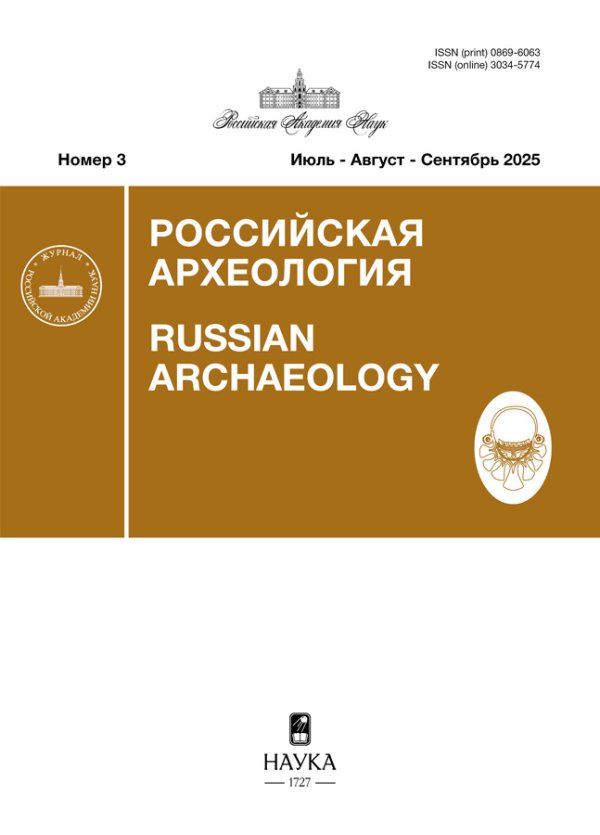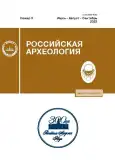AN INDIVIDUAL OF THE VOLINTSEVO PERIOD FROM KURILOVKA: THE FIRST ARCHAEOGENETIC DATA
- Authors: Andreeva T.V.1,2,3, Malyarchuk A.B.2,3, Rodinkova V.E.3, Soshkina A.D.2,3, Rozhdestvenskikh E.V.1, Dobrovolskaya M.V.3, Rogaev E.I.1,3,4
-
Affiliations:
- Centre for Genetics and Life Sciences, Sirius University
- Vavilov Institute of General Genetics RAS
- Centre for Genetics and Genetic Technologies, Lomonosov Moscow State University
- University of Massachusetts Chan Medical School, Department of Psychiatry
- Issue: No 3 (2023)
- Pages: 57-71
- Section: ARTICLES
- URL: https://journals.rcsi.science/0869-6063/article/view/138912
- DOI: https://doi.org/10.31857/S0869606323030030
- EDN: https://elibrary.ru/KGTTIT
- ID: 138912
Cite item
Full Text
Abstract
Despite the achievements of recent years of palaeogenomic research, the genetic features and diversity of the early Slavic population remain unexplored due to the cremation ritual common in the ancient Slavic tribes. Therefore, each find of an Early Slavic site is an important material. Such a unique Early Slavic object is an individual whose remains were found in a dwelling attributed to the Volintsevo culture from the Kurilovka 2 site in Kursk Region, which dates back to the end of the 7th – first half/middle of the 8th century AD. We extracted DNA from the tooth and used it for genetic analysis. We reconstructed the complete mitochondrial DNA sequence and determined that it belongs to the European haplogroup H1b. The results of the phylogenetic analysis testify the common maternal lineages of the individual from Kurilovka with Medieval and modern European samples and suggest a commonality of the early Slavic and northwestern European mitochondrial lineages.
About the authors
Tatiana V. Andreeva
Centre for Genetics and Life Sciences, Sirius University; Vavilov Institute of General Genetics RAS; Centre for Genetics and Genetic Technologies, Lomonosov Moscow State University
Author for correspondence.
Email: an_tati@mail.ru
Russia, Sochi; Russia, Moscow; Russia, Moscow
Alexandra B. Malyarchuk
Vavilov Institute of General Genetics RAS; Centre for Genetics and Genetic Technologies, Lomonosov Moscow State University
Author for correspondence.
Email: sasha-m98@mail.ru
Russia, Moscow; Russia, Moscow
Vlasta E. Rodinkova
Centre for Genetics and Genetic Technologies, Lomonosov Moscow State University
Author for correspondence.
Email: vlasta2004@mail.ru
Russia, Moscow
Anna D. Soshkina
Vavilov Institute of General Genetics RAS; Centre for Genetics and Genetic Technologies, Lomonosov Moscow State University
Author for correspondence.
Email: anna.soshkina91@gmail.com
Russia, Moscow; Russia, Moscow
Elizaveta V. Rozhdestvenskikh
Centre for Genetics and Life Sciences, Sirius University
Author for correspondence.
Email: l.i.r.o@mail.ru
Russia, Sochi
Maria V. Dobrovolskaya
Centre for Genetics and Genetic Technologies, Lomonosov Moscow State University
Author for correspondence.
Email: mk_pa@mail.ru
Russia, Moscow
Evgeny I. Rogaev
Centre for Genetics and Life Sciences, Sirius University; Centre for Genetics and Genetic Technologies, Lomonosov Moscow State University; University of Massachusetts Chan Medical School, Department of Psychiatry
Author for correspondence.
Email: rogaev.ei@talantiuspeh.ru
Russia, Sochi; Russia, Moscow; USA, Shrewsbury
References
- AmtDB (Electronic resource). URL: https://amtdb.org/.
- Andreeva T.V., Manakhov A.D., Gusev F.E. et al., 2022. Genomic Analysis of a Novel Neanderthal from Mezmaiskaya Cave Provides Insights into the Genetic Relationships of Middle Palaeolithic Populations. Scientific Reports, 12, 13016. doi: 10.1038/s41598-022-16164-9
- De Barros Damgaard P., Marchi N., Rasmussen S.et al., 2018. 137 Ancient Human Genomes from across the Eurasian Steppes. Nature, 557, 7705, pp. 369–374. doi: 10.1038/s41586-018-0094-2
- BLAST (Electronic resource). URL: https://blast.ncbi.nlm.nih.gov
- Etnokul’turnaya karta territorii Ukrainskoy SSR v I tys. n.e. [Europe from La Tene to the Middle Ages: the barbarian world and the birth of Slavic cultures]. V.D. Baran, ed. Kiev: Naukova dumka, 1985. 184 p.
- Gansauge M.T., Gerber T., Glocke I. et al., 2017. Single-Stranded DNA Library Preparation from Highly Degraded DNA Using T4 DNA Ligase. Nucleic Acids Research, vol. 45, iss. 10, pp. e79. doi: 10.1093/nar/gkx033
- Gavritukhin I.O., 1997. Chronology of the Prague culture. Trudy VI Mezhdunarodnogo Kongressa slavyanskoy arkheologii [Works of the VI International congress of Slavic archaeology], 3. V.V. Sedov, ed. Moscow, pp. 39–52. (In Russ.)
- Gavritukhin I.O., Shcheglova O.A., 1996. Chronology of the initial phases of the Volintsevo type sites. Gaponovskiy klad i ego kul’turno-istoricheskiy kontekst [The Gaponovo hoard and its cultural and historical context]. Moscow: Institut arkheologii Rossiyskoy akademii nauk, pp. 133–135. (Ranneslavyanskiy mir. Arkheologiya slavyan i ikh sosedey, 3). (In Russ.) GenBank (Electronic resource). URL: www.ncbi.nlm.nih.gov/genbank/.
- González-Fortes G., Tassi F., Trucchi E. et al., 2019. A Western Route of Prehistoric Human Migration from Africa into the Iberian Peninsula. Proceedings of the Royal Society. B: Biological Sciences, vol. 286, iss. 1895, 20182288. doi: 10.1098/rspb.2018.2288
- Grela M., Jakubczak A., Kowalczyk M., Listos P., Gry-zińska M., 2021. Effectiveness of Various Methods of DNA Isolation from Bones and Teeth of Animals Exposed to High Temperature. Journal of Forensic and Legal Medicine, 78, 102131. doi: 10.1016/j.jflm.2021.102131
- Ian Logan – mtDNA (Electronic resource). URL: http://www.ianlogan.co.uk.
- Jónsson H., Ginolhac A., Schubert M., Johnson P.L.F., Orlando L., 2013. MapDamage2.0: Fast Approximate Bayesian Estimates of Ancient DNA Damage Parameters. Bioinformatics, 29, pp. 1682–1684. doi: 10.1093/bioinformatics/btt193
- Juras A., Ehler E., Chyleński M. et al., 2021. Maternal Genetic Origin of the Late and Final Neolithic Human Populations from Present-Day Poland. American Journal of Physical Anthropology, vol. 176, iss. 2, pp. 223–36. doi: 10.1002/ajpa.24372
- Katoh K., Standley D.M., 2013. MAFFT Multiple Sequence Alignment Software Version 7: Improvements in Performance and Usability. Molecular Biology and Evolution, vol. 30, iss. 4, pp. 772–780. doi: 10.1093/molbev/mst010
- Kleshchenko E.A., Reshetova I.K., 2019. Paleoantropologicheskie materialy v rekonstruktsiyakh obraza zhizni i pogrebal’noy obryadnosti rannesrednevekovogo naseleniya Vostochnoy Evropy [Palaeoanthropological materials in reconstructions of the lifestyle and funeral rites of East European early medieval population]. Moscow: Institut arkheologii Rossiyskoy akademii nauk. 224 p.
- Knipper C., Mittnik A., Massy K. et al., 2017. Female Exogamy and Gene Pool Diversification at the Transition from the Final Neolithic to the Early Bronze Age in Central Europe. Proceedings of the National Academy of Sciences of the United States of America, vol. 114, 38, pp. 10083–10088. doi: 10.1073/pnas.1706355114
- Komar A.V., 2012. Polyans and Severians. Drevneyshie gosudarstva Vostochnoy Evropy [Earliest states of Eastern Europe], 2010. Predposylki i puti obrazovaniya Drevnerusskogo gosudarstva [Prerequisites and ways of the Rus state formation]. Moscow: Russkiy Fond Sodeystviya Obrazovaniyu i Nauke, pp. 128–191. (In Russ.)
- Kristiansen K., 2022. Archaeology and the genetic revolution in European prehistory. Cambridge: Cambridge University Press. 76 p.
- Kumar S., Stecher G., Li M., Knyaz Ch., Tamura K., 2018. MEGA X: Molecular Evolutionary Genetics Analysis across Computing Platforms. Molecular Biology and Evolution, vol. 35, iss. 6, pp. 1547–1549. doi: 10.1093/molbev/msy096
- Li H., Durbin R., 2009. Fast and Accurate Short Read Alignment with Burrows-Wheeler Transform. Bioinformatics, vol. 25, iss. 14, pp. 1754–1760. doi: 10.1093/bioinformatics/btp324
- Loogväli E.-L., Roostalu U., Malyarchuk B.A. et al., 2004. Disuniting Uniformity: A Pied Cladistic Canvas of MtDNA Haplogroup H in Eurasia. Molecular Biology and Evolution, vol. 21, iss. 11, pp. 2012–2021. doi: 10.1093/molbev/msh209
- Margaryan A., Lawson D.J., Sikora M. et al., 2020. Population Genomics of the Viking World. Nature, 585, 7825, pp. 390–396. doi: 10.1038/s41586-020-2688-8
- Nikitin A.G., Potekhina I., Rohland N. et al., 2017. Mitochondrial DNA Analysis of Eneolithic Trypillians from Ukraine Reveals Neolithic Farming Genetic Roots. PLOS ONE, 12, 2, e0172952. doi: 10.1371/journal.pone.0172952
- O’Sullivan N., Posth C., Coia V. et al., 2018. Ancient Genome-Wide Analyses Infer Kinship Structure in an Early Medieval Alemannic Graveyard. Science Advances, vol. 4, 9, 1262. doi: 10.1126/sciadv.aao1262
- Oblomskiy A.M., Shcheglova O.A., 1996. Some features of the culture of Volintsevo type sites and controversies of their origin. Gaponovskiy klad i ego kul’turno-istoricheskiy kontekst [The Gaponovo hoard and its cultural and historical context]. Moscow: Institut arkheologii Rossiyskoy akademii nauk, pp. 131–133. (Ranneslavyanskiy mir. Arkheologiya slavyan i ikh sosedey, 3). (In Russ.)
- Olalde I., Brace S., Allentoft M.E. et al., 2018. The Beaker Phenomenon and the Genomic Transformation of Northwest Europe. Nature, 555, 7695, pp. 190–196. doi: 10.1038/nature25738
- Olasz J., Seidenberg V., Hummel S. et al., 2019. DNA Profiling of Hungarian King Béla III and Other Skeletal Remains Originating from the Royal Basilica of Székesfehérvár. Archaeological and Anthropological Sciences, 11, 4, pp. 1345–1357. doi: 10.1007/s12520-018-0609-7
- Ottoni C., Koon H.E.C., Collins M.J. et al., 2009. Preservation of Ancient DNA in Thermally Damaged Archaeological Bone. Naturwissenschaften, 96, 2, pp. 267–278. doi: 10.1007/s00114-008-0478-5
- Ottoni C., Primativo G., Kashani B.H. et al., 2010. Mitochondrial Haplogroup H1 in North Africa: An Early Holocene Arrival from Iberia. PLOS ONE, 5 (10), e13378. doi: 10.1371/journal.pone.0013378
- Översti S., Majander K., Salmela E. et al., 2019. Human Mitochondrial DNA Lineages in Iron-Age Fennoscandia Suggest Incipient Admixture and Eastern Introduction of Farming-Related Maternal Ancestry. Scientific Reports, 9, 16883. doi: 10.1038/s41598-019-51045-8
- PhyloTree – mtDNA tree Build (Electronic resource). URL: http://www.phylotree.org.
- Robinson P., Zemo jtel T., 2018. Integrative Genomics Viewer (IGV): Visualizing Alignments and Variants. In Computational Exome and Genome Analysis. New York, pp. 233–245. doi: 10.1201/9781315154770-17
- Rodinkova V.E., 1996. Early Slavic sites of the Middle Dnieper and the Dnieper Left Bank with dating finds. Gaponovskiy klad i ego kul’turno-istoricheskiy kontekst [The Gaponovo hoard and its cultural and historical context]. Moscow: Institut arkheologii Rossiyskoy akademii nauk, pp. 155–162. (Ranneslavyanskiy mir. Arkheologiya slavyan i ikh sosedey, 3). (In Russ.)
- Rogaev E.I., Grigorenko A.P., Moliaka Y.K. et al., 2009. Genomic Identification in the Historical Case of the Nicholas II Royal Family. Proceedings of the National Academy of Sciences of the United States of America, vol. 106, 13, pp. 5258–5263. doi: 10.1073/pnas.0811190106
- Roostalu U., Kutuev I., Loogväli E. L. et al., 2007. Origin and Expansion of Haplogroup H, the Dominant Human Mitochondrial DNA Lineage in West Eurasia: The Near Eastern and Caucasian Perspective. Molecular Biology and Evolution, vol. 24, iss. 2, pp. 436–448. doi: 10.1093/molbev/msl173
- Saag L., Vasilyev S.V., Varul L. et al., 2021. Genetic Ancestry Changes in Stone to Bronze Age Transition in the East European Plain. Science Advances, vol. 7, 4. 6535. doi: 10.1126/sciadv.abd6535
- Schubert M., Lindgreen S., Orlando L., 2016. AdapterRemoval v2: Rapid Adapter Trimming, Identification, and Read Merging. BMC Research Notes, 9, 88. doi: 10.1186/s13104-016-1900-2
- Shneevays Y., 2017. Ceramics as evidence of identity and cultural transfer? Saxon and Slavic pottery of the 8th–10th centuries AD in the Lower Elba region. Evropa ot Latena do Srednevekov’ya: varvarskiy mir i rozhdenie slavyanskikh kul’tur. [Europe from La Tene to the Middle Ages: the barbarian world and the birth of Slavic cultures]. V.E. Rodinkova, O.S. Rumyantseva, eds. Moscow: Institut arkheologii Rossiyskoy akademii nauk, pp. 90–102. (Ranneslavyanskiy mir. Arkheologiya slavyan i ikh sosedey, 19). (In Russ.)
- Stolarek I., Handschuh L., Juras A. et al., 2019. Goth Migration Induced Changes in the Matrilineal Genetic Structure of the Central-East European Population. Scientific Reports, 9, 6737. doi: 10.1038/s41598-019-43183-w
- Syrovatko A.S., Kleshchenko E.A., 2017. Burials of cremated remains of the 12th century AD: new research in the Kremenye mound cemetery. Arkheologiya Podmoskov’ya: materialy nauchnogo seminara [Archaeology of Moscow region: Proceedings of scientific seminar], 13. Moscow: Institut arkheologii Rossiyskoy akademii nauk, pp. 45–56. (In Russ.)
- Szeifert B., Gerber D., Csáky V. et al., 2022. Tracing Genetic Connections of Ancient Hungarians to the 6th–14th Century Populations of the Volga-Ural Region. Human Molecular Genetics, 31, 19, pp. 3266–3280. doi: 10.1093/hmg/ddac106
- Tassi F., Vai S., Ghirotto S. et al., 2017. Genome Diversity in the Neolithic Globular Amphorae Culture and the Spread of Indo-European Languages. Proceedings of the Royal Society. B: Biological Sciences, vol. 284, iss. 1867, 20171540. doi: 10.1098/rspb.2017.1540
- Van Oven M., Kayser M., 2009. Updated Comprehensive Phylogenetic Tree of Global Human Mitochondrial DNA Variation. Human Mutation, vol. 30, no. 2, pp. e386–e394. doi: 10.1002/humu.20921
- Wang Ch.Ch., Posth C., Furtwängler A. et al., 2021. Genome-Wide Autosomal, MtDNA, and Y Chromosome Analysis of King Bela III of the Hungarian Arpad Dynasty. Scientific Reports, 11, 19210. doi: 10.1038/s41598-021-98796-x
- Weissensteiner H., Pacher D., Kloss-Brandstätter A. et al., 2016. HaploGrep 2: Mitochondrial Haplogroup Classification in the Era of High-Throughput Sequencing. Nucleic Acids Research, 44, W1, pp. W58-W63. doi: 10.1093/nar/gkw233
- YFull – MTree 1.02 (Electronic resource). URL: https://www.yfull.com/mtree/.
Supplementary files















